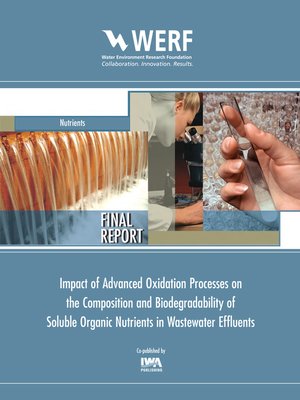Impact of Advanced Oxidation Processes on the Composition and Biodegradability of Soluble Organic Nutrients in Wastewater Effluents
ebook ∣ WERF Research Report
By April Z. Gu

Sign up to save your library
With an OverDrive account, you can save your favorite libraries for at-a-glance information about availability. Find out more about OverDrive accounts.
Find this title in Libby, the library reading app by OverDrive.



Search for a digital library with this title
Title found at these libraries:
| Library Name | Distance |
|---|---|
| Loading... |
The characteristics and bioavailability of wastewater derived "refractory" organic nutrients and their susceptibility to removal has drawn significant attention from both regulatory agencies and wastewater utilities. As suggested by recent studies, the bioavailability of effluent organic nutrients to algae is relatively high. This implies that discharge of effluent organic nutrients from water resource recovery facilities (WRRFs) may contribute to the eutrophication potential. Therefore, investigation into alternative technologies for organic nutrients transformation and reduction, and the mechanisms involved in those processes, is warranted with the ultimate goal of improved eutrophication control. Advanced oxidation processes (AOPs) have been shown to be capable of reducing the concentrations of soluble organic nutrients and converting specific nutrient-containing organic compounds into simpler or more biodegradable forms. The overall objective of this study was to investigate the impact of AOP treatments on the speciation and composition of soluble nutrients and consequently their biodegradability in wastewater effluents. Secondary or tertiary effluents from three selected wastewater treatment plants were collected. Each effluent was treated with three different AOPs, including low-pressure ultraviolet (UV) irradiation, hydrogen peroxide (H2O2), and a combination of UV and H2O2. Both untreated and AOP-treated effluents were subjected to a comprehensive analysis for wastewater characterization, nitrogen speciation analysis, phosphorus speciation analysis, and soluble organic nitrogen (SON) biodegradability assays.The AOP processes at the conditions applied did not lead to significant changes in the SON concentrations for the wastewater effluents examined. However, fingerprinting and quantification of the dissolved organic matter (DOM) in untreated and AOP treated samples using fluorescence spectroscopy combined with parallel factor analysis revealed changes in DOM pool composition with various AOP treatments. This suggests that there may also be changes in organic nutrients composition. Based on biodegradability assessments, AOP treatments likely changed the composition and biodegradability of the SON compounds in the effluents. The impact of AOP treatments on effluent biodegradable SON (BSON) varied depending on the effluent and the AOP treatment. The BSON concentration increased by 0.02-0.2 mg/L (4-47%) after AOP treatment in one effluent, while the concentration decreased by 0.12-0.14 mg/L (60-69%) in another sample. For the secondary effluent sample, release of ammonia (0.04-0.1 mg/L) was observed during 15-day BSON incubation period for those samples treated with H2O2 or UV/H2O2, suggesting that the AOP treatments might lead to oxidation of colloidal organic matter in the filtered effluent. Comparison of the results among the three different AOPs indicated that the combined UV/H2O2 treatment was more effective at oxidizing some of the organic or organically bound nutrients.The impact of AOP treatment on effluent soluble organic phosphorus (SOP) composition varied depending on the effluents. For two WRRFs, AOP treatment at the dose conditions applied led to a decrease in the SOP level and seemed to convert it into SAHP, indicating a possible increase in effluent soluble phosphorus bioavailability. Comparison of the results among the three different AOPs indicated that the combined UV/H2O2 treatment was more effective at oxidizing some of the organic or organically-bound...







